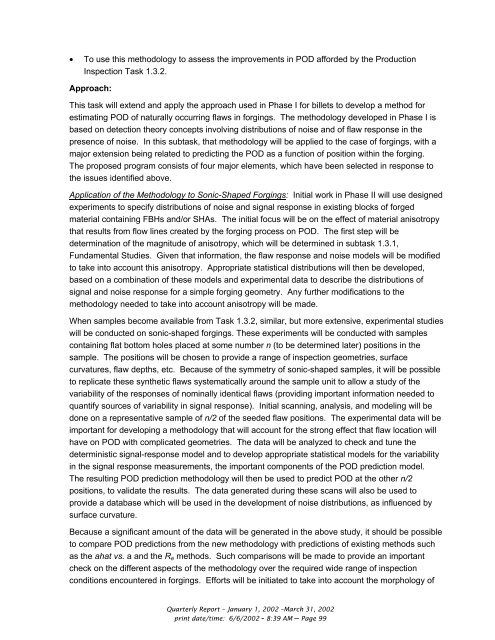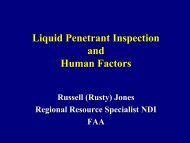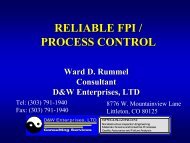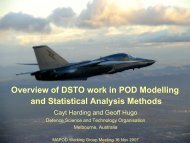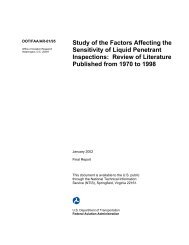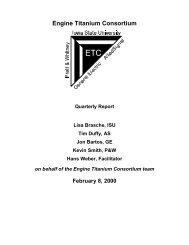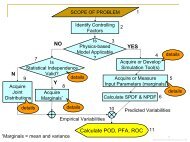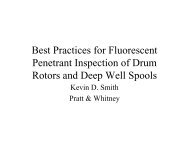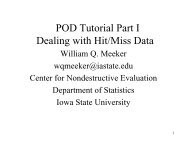Engine Titanium Consortium - Center for Nondestructive Evaluation ...
Engine Titanium Consortium - Center for Nondestructive Evaluation ...
Engine Titanium Consortium - Center for Nondestructive Evaluation ...
Create successful ePaper yourself
Turn your PDF publications into a flip-book with our unique Google optimized e-Paper software.
• To use this methodology to assess the improvements in POD af<strong>for</strong>ded by the Production<br />
Inspection Task 1.3.2.<br />
Approach:<br />
This task will extend and apply the approach used in Phase I <strong>for</strong> billets to develop a method <strong>for</strong><br />
estimating POD of naturally occurring flaws in <strong>for</strong>gings. The methodology developed in Phase I is<br />
based on detection theory concepts involving distributions of noise and of flaw response in the<br />
presence of noise. In this subtask, that methodology will be applied to the case of <strong>for</strong>gings, with a<br />
major extension being related to predicting the POD as a function of position within the <strong>for</strong>ging.<br />
The proposed program consists of four major elements, which have been selected in response to<br />
the issues identified above.<br />
Application of the Methodology to Sonic-Shaped Forgings: Initial work in Phase II will use designed<br />
experiments to specify distributions of noise and signal response in existing blocks of <strong>for</strong>ged<br />
material containing FBHs and/or SHAs. The initial focus will be on the effect of material anisotropy<br />
that results from flow lines created by the <strong>for</strong>ging process on POD. The first step will be<br />
determination of the magnitude of anisotropy, which will be determined in subtask 1.3.1,<br />
Fundamental Studies. Given that in<strong>for</strong>mation, the flaw response and noise models will be modified<br />
to take into account this anisotropy. Appropriate statistical distributions will then be developed,<br />
based on a combination of these models and experimental data to describe the distributions of<br />
signal and noise response <strong>for</strong> a simple <strong>for</strong>ging geometry. Any further modifications to the<br />
methodology needed to take into account anisotropy will be made.<br />
When samples become available from Task 1.3.2, similar, but more extensive, experimental studies<br />
will be conducted on sonic-shaped <strong>for</strong>gings. These experiments will be conducted with samples<br />
containing flat bottom holes placed at some number n (to be determined later) positions in the<br />
sample. The positions will be chosen to provide a range of inspection geometries, surface<br />
curvatures, flaw depths, etc. Because of the symmetry of sonic-shaped samples, it will be possible<br />
to replicate these synthetic flaws systematically around the sample unit to allow a study of the<br />
variability of the responses of nominally identical flaws (providing important in<strong>for</strong>mation needed to<br />
quantify sources of variability in signal response). Initial scanning, analysis, and modeling will be<br />
done on a representative sample of n/2 of the seeded flaw positions. The experimental data will be<br />
important <strong>for</strong> developing a methodology that will account <strong>for</strong> the strong effect that flaw location will<br />
have on POD with complicated geometries. The data will be analyzed to check and tune the<br />
deterministic signal-response model and to develop appropriate statistical models <strong>for</strong> the variability<br />
in the signal response measurements, the important components of the POD prediction model.<br />
The resulting POD prediction methodology will then be used to predict POD at the other n/2<br />
positions, to validate the results. The data generated during these scans will also be used to<br />
provide a database which will be used in the development of noise distributions, as influenced by<br />
surface curvature.<br />
Because a significant amount of the data will be generated in the above study, it should be possible<br />
to compare POD predictions from the new methodology with predictions of existing methods such<br />
as the ahat vs. a and the R e methods. Such comparisons will be made to provide an important<br />
check on the different aspects of the methodology over the required wide range of inspection<br />
conditions encountered in <strong>for</strong>gings. Ef<strong>for</strong>ts will be initiated to take into account the morphology of<br />
Quarterly Report – January 1, 2002 –March 31, 2002<br />
print date/time: 6/6/2002 - 8:39 AM – Page 99


